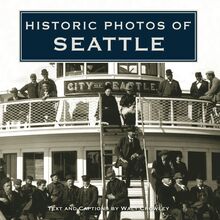Historic Photos of Baton Rouge , livre ebook
170
pages
English
Ebooks
2008
Vous pourrez modifier la taille du texte de cet ouvrage
Obtenez un accès à la bibliothèque pour le consulter en ligne En savoir plus
Découvre YouScribe en t'inscrivant gratuitement
Découvre YouScribe en t'inscrivant gratuitement
170
pages
English
Ebooks
2008
Vous pourrez modifier la taille du texte de cet ouvrage
Obtenez un accès à la bibliothèque pour le consulter en ligne En savoir plus
Publié par
Date de parution
15 octobre 2008
Nombre de lectures
4
EAN13
9781618586032
Langue
English
Poids de l'ouvrage
8 Mo
With a history tied to the Mississippi River, Baton Rouge has grown from its colonial past as a military outpost favored by the French, English, and Spanish, in turn, into an American city of modern industry and rich diversity. Through the years, the people of Baton Rouge have weathered travails while developing a unique culture and city. Baton Rouge has seen occupation during the Civil War, the destruction by fire and reconstruction of the State Capitol, catastrophic flooding, and political and civil conflict—but also the economic impact of a growing port, the historic arrivals of Louisiana State University and Southern University, and the joyful rituals of Saturday football and the Washington’s Birthday Firemen’s Parade.
Telling the city’s story in words and vivid black and white images, Historic Photos of Baton Rouge documents 100-plus years in the life of the "Red Stick” as only the camera can capture it—one engaging image at a time.
Publié par
Date de parution
15 octobre 2008
Nombre de lectures
4
EAN13
9781618586032
Langue
English
Poids de l'ouvrage
8 Mo
HISTORIC PHOTOS OF
BATON ROUGE
T EXT AND C APTIONS BY M ARK E. M ARTIN
The Baton Rouge City Park, initially designed and constructed in the mid-1920s, included a golf course, zoo, and amusement pavilion built around a small lake created by digging out swampy lowlands. During the Depression, the Works Progress Administration funded a project to expand the original lake and construct more lakes south toward Bayou Duplantier and the Louisiana State University campus. This image from around 1935 provides a view across the lake toward the university.
HISTORIC PHOTOS OF
BATON ROUGE
Turner Publishing Company
200 4th Avenue North Suite 950
Nashville, Tennessee 37219
(615) 255-2665
www.turnerpublishing.com
Historic Photos of Baton Rouge
Copyright 2008 Turner Publishing Company
All rights reserved.
This book or any part thereof may not be reproduced or transmitted in any form or by any means, electronic or mechanical, including photocopying, recording, or by any information storage and retrieval system, without permission in writing from the publisher.
Library of Congress Control Number: 2008901849
ISBN-13: 978-1-59652-441-5
Printed in China
08 09 10 11 12 13 14 15-0 9 8 7 6 5 4 3 2 1
C ONTENTS
A CKNOWLEDGMENTS
P REFACE
N INETEENTH -C ENTURY B ATON R OUGE (1850 S -1899)
F OOTBALL AND A S TRONG E CONOMY (1900-1919)
A N EW C AMPUS AND A T ERRIBLE F LOOD (1920-1929)
T HE H UEY P. L ONG L EGACY (1930-1939)
T HE W AR Y EARS AND B EYOND (1940-1949)
P OSTWAR B ATON R OUGE (1950-1959)
A T URBULENT D ECADE (1960-1969)
C HANGES BY THE R IVER (1970-1979)
N OTES ON THE P HOTOGRAPHS
Citizens enjoy watermelon in the shade of the Texas Pacific Railway office gallery on Main Street. Behind the three men, a poster announces a February 20, 1892, Democratic Party rally.
A CKNOWLEDGMENTS
This volume, Historic Photos of Baton Rouge , is the result of the cooperation and efforts of many individuals, organizations, and corporations. It is with great thanks that we acknowledge the valuable contribution of the following for their generous support:
Library of Congress
Louisiana State University-Special Collections
State Library of Louisiana
My undying thanks to L. A. B. for her insightful comments and editorial advice.
- Mark E. Martin
P REFACE
Baton Rouge has thousands of historic photographs that reside in archives, both locally and nationally. This book began with the observation that, while those photographs are of great interest to many, they are not easily accessible. During a time when Baton Rouge is looking ahead and evaluating its future course, many people are asking, How do we treat the past? These decisions affect every aspect of the city-architecture, public spaces, commerce, infrastructure-and these, in turn, affect the way that people live their lives. This book seeks to provide easy access to a valuable, objective look into the history of Baton Rouge.
The power of photographs is that they are less subjective than words in their treatment of history. Although the photographer can make decisions regarding subject matter and how to capture and present it, photographs do not provide the breadth of interpretation that text does. For this reason, they offer an original, untainted perspective that allows the viewer to interpret and observe.
This project represents countless hours of review and research. The researchers and writer have reviewed thousands of photographs in numerous archives. We greatly appreciate the generous assistance of the individuals and organizations listed in the acknowledgments of this work, without whom this project could not have been completed.
The goal in publishing this work is to provide broader access to this set of extraordinary photographs that seek to inspire, provide perspective, and evoke insight that might assist people who are responsible for determining Baton Rouge s future. In addition, the book seeks to preserve the past with adequate respect and reverence.
With the exception of touching up imperfections caused by the damage of time and cropping where necessary, no other changes have been made to the photographs in this volume. The focus and clarity of many images is limited to the technology and the ability of the photographer at the time they were taken.
The work is divided into eras. Beginning with some of the earliest known photographs of Baton Rouge, the first section records photographs through the end of the nineteenth century. The second section spans the beginning of the twentieth century through World War I. Sections Three through Eight then move decade by decade from the 1920s through the 1970s.
In each of these sections we have made an effort to capture various aspects of life through our selection of photographs. People, commerce, transportation, infrastructure, religious institutions, and educational institutions have been included to provide a broad perspective.
We encourage readers to reflect as they go walking in Baton Rouge, strolling through the city, its parks, and its neighborhoods. It is the publisher s hope that in utilizing this work, longtime residents will learn something new and that new residents will gain a perspective on where Baton Rouge has been, so that each can contribute to its future.
- Todd Bottorff, Publisher
The photographer of numerous images in this collection, Andrew D. Lytle pointed his lens out his studio window sometime around 1866 and captured this view looking up Main Street away from the Mississippi River. Businesses visible include the Brooks Drug Store at 210 Main and Marion P. McCarthy s Photographic and Ambrotype Gallery at 314 Main. The blunt tower seen in the distance was part of Saint Joseph Catholic Church at 403 Main. Lytle s studio stood at 208 Main.
N INETEENTH -C ENTURY B ATON R OUGE
(1850 S -1899)
Having first arrived in the area in 1699, the French never really settled at Baton Rouge. It took the British, who acquired the Louisiana territory in 1763 following the French and Indian War, to found a true settlement, beginning with two fortifications: Fort Bute on Bayou Manchac and a much larger Fort New Richmond at Baton Rouge. In September 1779, Spanish forces under Governor Don Bernardo de Galvez captured both of the British forts and established Spanish rule. Baton Rouge became a true town under the Spanish; two areas, Beauregard Town and Spanish Town, were laid out and developed by 1805.
Changing international politics, however, removed from Spain the West Florida Territory of which Baton Rouge was a part. With the town completely surrounded by American territory by 1810, a small group of American rebels captured the Spanish Fort San Carlos (Fort New Richmond under the British) in Baton Rouge. On September 23, 1810, the new government declared all territory south of the 31st parallel, west of the Perdido River, east of the Mississippi River, and north of Lake Pontchartrain and along the coast of the Gulf of Mexico as the West Florida Republic. Ninety days later, the West Florida Republic became part of the American territory of Orleans. The small town growing up around the fort became Baton Rouge permanently.
By 1860 Baton Rouge had grown to include 4,181 whites and 1,247 slaves within its town limits. Much would change over the following decades: Louisiana would secede from the Union, fully one-third of Baton Rouge would be burnt by its occupying forces, the State Capitol would burn in a separate conflagration, African American legislators would serve in the Reconstruction government, the state would be readmitted to the Union, the Capitol would be rebuilt, and the Louisiana State University and Agricultural and Mechanical College (LSU A M, or LSU) would settle in town and grow. Baton Rouge would very slowly recover from the Civil War until it stood on the edge of major changes at the end of the nineteenth century.
Architect James Harrison Dakin designed the Louisiana State Capitol in what he referred to as the castellated Gothic style. Construction took two years, 1847-1849, at a cost of nearly $400,000. This image from around 1860 also shows businesses that were built on the flood plane of the Mississippi River despite the lack of a riverfront levee.
With a population of a little over 4,000 in 1860, Baton Rouge served as an important warehousing and transshipment port for plantations on both sides of the Mississippi. Local merchants catered not only to the permanent population but also to a large number of transients traveling the river. Photographed in 1859, these butchers worked in the central market a few blocks off the river.
The western side of Baton Rouge ends at the Mississippi River. In the late 1850s, when Andrew D. Lytle took this photograph of a riverside social event, the townspeople attending would have ridden or walked dirt streets to the river s edge, in this case at the intersection of North and Lafayette streets.
Around 1861, sometime before the capture of Baton Rouge, Lytle photographed these militia groups meeting in town. Artillery pieces taken from the Federal Arsenal provided them with weapons, powder, and ammunition. Among the groups here is the Washington Artillery of New Orleans, established in 1838 and still active as the 1st Battalion, 141st Field Artillery.
The traveling-photographer team of McPherson and Oliver is credited with this image of the camp of General Christopher Colon Augur s 19th Army Corps, 3rd Brigade, on the north edge of Baton Rouge around 1863. This area had been a United States Army arsenal and camp before the war. Tens of thousands of Federal troops and sailors lived in Baton Rouge before the fall of Port Hudson-the last Confederate stronghold on the Mississippi-less than 25 miles upriver.
This building photographed about 1863 by L. I. Prince, a traveling photographer based out of New Orleans, was one of the many structures on the grounds of the Baton Rouge Arsenal. An important frontier military i














